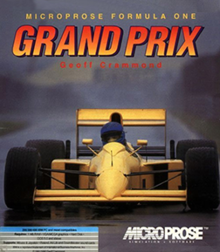Formula One Grand Prix (Geoff Crammond)
| Formula One Grand Prix | |
|---|---|
 |
|
| Developer(s) | MicroProse |
| Publisher(s) | MicroProse |
| Designer(s) | Geoff Crammond |
| Series | Grand Prix |
| Platform(s) | PC (DOS) Amiga Atari ST |
| Release | January 1992 |
| Genre(s) | Racing simulator game |
| Mode(s) |
Single-player Multiplayer |
Formula One Grand Prix (known as World Circuit in the United States) is a racing simulator released in 1992 by MicroProse for the Atari ST, Amiga and PC created by game designer Geoff Crammond. It is often referred to as Grand Prix 1, MicroProse Grand Prix, or just F1GP. Although the game itself was not affiliated officially with the FIA or any Formula One drivers, team liveries and driver helmets were accurate to represent the 1991 season, but the names were fictional. The game is a simulation of Formula One racing at the time and was noted for its 3D graphics and attention to detail, in particular the players ability to edit the teams and drivers and set up their car to their own personal specifications. The game was ranked the 27th best game of all time by Amiga Power.
Grand Prix's success spawned three sequels, called Grand Prix 2, Grand Prix 3 and Grand Prix 4. These were exclusively PC games.
After Papyrus' Indianapolis 500: The Simulation, which was released three years earlier, it was the second serious 3D polygon-based racing sim (that is, without textures, except some for the scenery in the PC version). Although Indy 500 was strictly speaking first in pioneering many novel features, F1GP would make a bigger overall impression and impact because it featured Formula One race cars, and because it offered the player a complete season to compete in, featuring 16 F1 tracks to Papyrus' 1 track in Indy 500.
When Indy 500 and F1GP appeared, they were the very first to implement something that resembled "real world" racing physics, accurate track modelling and car handling that required skills somewhat similar to real-world driving skills to perform well. Both were also the first to offer meaningful options to tune the behaviour of the cars. Although not quite on the level of later simulations, the most important variables, such as gear ratios, tyre compounds and wing settings were available to tune and, more importantly, proved to make an actual difference when driving. Important were also the functional rearview mirrors and an "instant replay" system with a wide range of adjustable camera settings not seen in other games of the era.
...
Wikipedia
